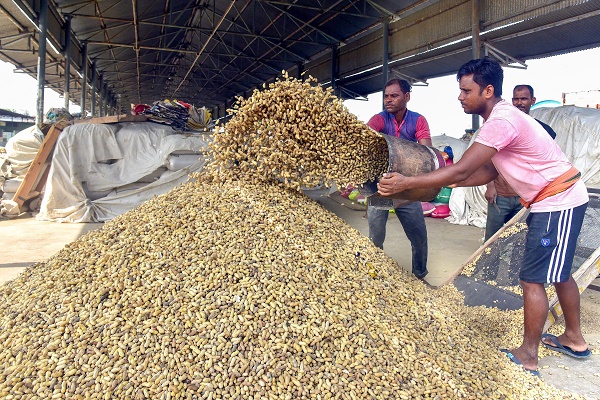Gold trading range for the day is 61590-62190 - Kedia Advisory

Gold:
Gold's recent settlement at 61868, reflecting a -0.22% decline, mirrors the intricate dance of market dynamics tied to the Federal Reserve's interest rate outlook. Policymakers persist in advocating for tight interest rates to steer inflation back to the targeted 2%, fostering a sustainable economic environment. However, the precious metal faces headwinds as expectations of imminent rate cuts fade, a consequence of robust consumer spending and full employment conditions maintaining elevated price pressures. The commentary from Atlanta Federal Reserve President Raphael Bostic adds a nuanced layer to the narrative. While open to earlier rate adjustments contingent on inflation decline, the baseline projects cuts starting in the third quarter. Regionally, gold's reception is divergent. In India, lackluster demand prevails, even with a correction in local prices, leading dealers to offer discounts of up to $9 per ounce over official domestic prices, down from the previous week's $13 discount. Weak retail demand in India for almost a month prompts caution among jewelers during the ongoing wedding season, resulting in a measured approach to inventory buildup. In contrast, China and Hong Kong experience increased demand ahead of Lunar New Year festivities, with premiums ranging from $42 to $54.2 per ounce over spot prices. From a technical standpoint, the market undergoes long liquidation, with a -0.87% drop in open interest to settle at 6522. Priced -136 rupees, Gold finds support at 61730, with potential testing of 61590 on the downside. Resistance is anticipated at 62030, and a breakthrough could propel prices towards 62190.
Trading Ideas:
* Gold trading range for the day is 61590-62190.
* Gold falls as investors reconsider outlook on interest rates by Fed
* Sell-off due to fading prospect of imminent rate cuts and still-high price pressures
* Markets see 55% chance of March rate cut vs 71% last week
Silver:
Silver experienced a downturn, settling at 70816 with a -0.9% decline, primarily attributed to growing uncertainties surrounding the timing of rate cuts by the U.S. Federal Reserve. Despite market attachment to the prospect of a March rate cut, recent cautious comments from Fed officials, including Atlanta Federal Reserve President Raphael Bostic, have introduced a level of skepticism. Bostic anticipates rate cuts commencing in the third quarter, emphasizing the need to calibrate policy to be less restrictive. Federal Reserve Governor Christopher Waller's statement aligns with this sentiment, indicating a lack of urgency for rapid rate cuts. The sharp and unexpected decline in U.S. jobless claims, underscoring a historically tight labor market, has tempered expectations for an imminent interest rate cut. Additionally, stronger-than-expected U.S. retail sales data and hawkish remarks from policymakers prompted investors to reconsider their bets on monetary easing. The business inventories report for November, revealing a second consecutive monthly decline, suggests potential subtraction from economic growth in the fourth quarter. The 0.1% dip in inventories, in line with expectations, contrasts with the 0.4% year-on-year increase. Technically, the silver market is marked by fresh selling, with a notable 7.21% increase in open interest, settling at 30804. The accompanying price drop of -644 rupees positions Silver with support at 70360, and a breach below could lead to a test of 69905 levels. On the upside, resistance is expected at 71260, and a breakthrough could see prices testing 71705.
Trading Ideas:
* Silver trading range for the day is 69905-71705.
* Silver dropped on doubts over early rate cuts by the U.S. Federal Reserve
* Markets still expect a rate cut in March despite cautious comments from Fed officials
* Atlanta Fed President expects rate cuts in the third quarter, aiming for less restrictive policy
Crude oil:
Crude oil saw a robust 2.6% increase, settling at 6265, driven by a confluence of factors including heightened geopolitical tensions, optimistic global oil demand forecasts, and a notable drop in U.S. crude stockpiles. The spike in geopolitical tensions, marked by reciprocal airstrikes between Pakistan and Iran, raised concerns globally. The U.S., expressing worry over the escalating situation, called for restraint among all parties involved. The International Energy Agency (IEA) contributed to the bullish sentiment by revising its 2024 global oil demand growth forecast. Predicting a rise of 1.24 million barrels per day (bpd) in 2024, the IEA's projection contrasts with OPEC's more conservative estimate of 2.25 million bpd. This divergence in forecasts reflects ongoing uncertainties surrounding the pace of global economic recovery and energy demand. In terms of U.S. inventory data, the Energy Information Administration (EIA) reported a more than expected decline in crude stocks by 2.5 million barrels to 429.9 million barrels for the week ending January 12. Notably, crude stocks at the Cushing, Oklahoma delivery hub also fell by 2.1 million barrels. While gasoline and distillate inventories increased, the overall drawdown in crude stocks provided a positive boost to prices. Technically, the market exhibits signs of short covering, with a -0.44% drop in open interest, settling at 11605. The accompanying price increase of 159 rupees positions crude oil with support at 6157. A breach below could lead to a test of 6050 levels. On the upside, resistance is anticipated at 6324, and a move above could propel prices towards 6384.
Trading Ideas:
* Crudeoil trading range for the day is 6050-6384.
* Crude oil gains amid geopolitical tensions, higher forecasts for global oil demand
* IEA has raised its 2024 global oil demand growth forecast, predicting a rise in global oil consumption.
* U.S. crude stocks fell more than expected, while gasoline and distillate inventories rose.
Natural gas:
Natural gas witnessed a substantial 3.84% decline, settling at 202.8, driven by a smaller-than-expected storage withdrawal and forecasts indicating a drop in demand alongside an increase in output due to milder weather conditions in late January. The U.S. Energy Information Administration (EIA) reported a withdrawal of 154 billion cubic feet (bcf) from storage during the week ending January 12. While this was smaller than the 164-bcf decline forecasted by analysts, it surpassed the withdrawal of 68 bcf during the same week last year and the five-year average decline of 126 bcf. The reduction in demand and rise in output are further emphasized by a decline in the flow of gas to U.S. liquefied natural gas (LNG) export plants, reaching a one-year low. Energy firms likely redirected some gas to the domestic market following extreme cold weather, which elevated U.S. power gas prices to multi-year highs in various regions. Financial company LSEG noted a drop in average gas output in the Lower 48 states to 103.2 billion cubic feet per day (bcfd) so far in January, down from a monthly record of 108.0 bcfd in December. On a daily basis, U.S. gas output is projected to rebound by 7.7 bcfd over the last two days, reaching 98.1 bcfd on Thursday. Technically, the natural gas market shows signs of long liquidation, with a notable -24.29% drop in open interest, settling at 12643. Accompanied by a price decrease of -8.1 rupees, natural gas finds support at 197.8. A breach below this level could lead to a test of 192.9, while resistance is expected at 205.9, and a move above could see prices testing 209.1.
Trading Ideas:
* Naturalgas trading range for the day is 192.9-209.1.
* Natural gas fell amid forecasts for decreased demand and increased output.
* Utilities pulled 154 bcf of gas out of storage, which was lower than the forecasted decline of 164 bcf.
* Gas output in the Lower 48 states decreased in January but is expected to increase in the coming days.
Copper:
Copper experienced a marginal decline of -0.41%, settling at 714.85, influenced by several factors shaping the global copper market. Notably, copper inventories in Shanghai Futures Exchange-monitored warehouses surged by 10.8% from the previous Friday, raising concerns about oversupply. This increase, coupled with the unexpected hold on medium-term facility rates by the People's Bank of China (PBoC), reflects China's cautious approach toward further stimulus measures amid slower-than-expected economic growth. The recent production halt at First Quantum's Cobre mine in Panama and a 25% reduction in copper output targets for the year by Anglo American due to soaring operational costs contribute to the overall supply concerns. In addition, copper stocks at major Chinese warehouses have surged by 40% since the beginning of the year, leading to a notable drop in the Yangshan copper premium as manufacturers exhibit reluctance in placing significant bids. Despite these challenges, China's refined copper production showed strength, increasing by 16.6% in December compared to the previous year, totaling around 1.17 million metric tons. The full-year refined copper output for 2023 reached approximately 12.99 million tons, representing a 13.5% increase from 2022.From a technical standpoint, the market is under long liquidation, marked by a -4.53% drop in open interest, settling at 3776. The accompanying price decrease of -2.95 rupees positions copper with support at 713.5. A breach below this level could lead to a test of 712.1, while resistance is anticipated at 716.3, with a move above potentially testing 717.7.
Trading Ideas:
* Copper trading range for the day is 712.1-717.7.
* Copper dropped as SHFE inventories rose 10.8% from last Friday
* China's refined copper production in December climbed 16.6% from the prior year to around 1.17 million metric tons
* First Quantum's Cobre mine in Panama halts production
Zinc:
Zinc closed marginally lower by -0.18%, settling at 219.35, as weak economic data from China, the world's largest consumer of metals, weighed on market sentiment. China's economic growth slightly missed forecasts, raising concerns, particularly about the property sector, as property sales measured by floor area plummeted by 23% in December. Other economic indicators for the same period revealed slower growth in retail sales, tepid investment growth, and signs of improvement in industrial output. Amid these economic uncertainties, the global zinc market registered a deficit of 71,600 metric tons in November 2023, up from a deficit of 62,500 tons in October, according to data from the International Lead and Zinc Study Group (ILZSG). However, for the first 11 months of 2023, there was an overall surplus of 211,000 tons, compared to a deficit of 86,000 tons during the same period in 2022. Chinese Premier Li Qiang, speaking at the World Economic Forum in Davos, reassured that the Chinese economy had rebounded and moved upward, estimating a growth rate of around 5.2% for 2023, slightly exceeding the official target of 5%. Li expressed confidence in the Chinese economy's ability to manage fluctuations, emphasizing the overall trend of long-term growth. Technically, the zinc market indicates signs of long liquidation, marked by a -12.61% drop in open interest, settling at 1948. The accompanying price decrease of -0.4 rupees places zinc with support at 218.5. A breach below this level could lead to a test of 217.7, while resistance is anticipated at 220, with a move above potentially testing 220.7.
Trading Ideas:
* Zinc trading range for the day is 217.7-220.7.
* Zinc ended with losses on weak Chinese economic data.
* Industrial output in China showed signs of improvement.
* The global zinc market deficit increased in November 2023.
Aluminium:
Aluminium prices experienced a decline of -0.63% to settle at 196.15 as of the latest trading session, influenced by a notable 25% surge in LME aluminium stocks since December 14. This increase suggests a robust supply of the metal in the market. The backdrop of China missing economic growth forecasts and continued struggles in the debt-heavy property sector contributed to the market sentiment. In terms of demand, China's 28% surge in aluminium imports in 2023, totaling 3.06 million metric tons, reflects the country's status as the world's largest consumer of the metal. Notably, China's primary aluminium consumption was projected to grow by 3.9% to reach 42.5 million tons, driven by increased demand from the solar and automotive sectors. Concurrently, China's domestic production of primary aluminium rose by 3.7% to 41.59 million metric tons in 2023, with December alone witnessing a 4.9% YoY increase to 3.59 million tons, according to data from the National Bureau of Statistics. Technically, the market is undergoing long liquidation, marked by a 16.9% drop in open interest to settle at 2699. Prices have decreased by -1.25 rupees. The current support for Aluminium is at 195.9, with a potential test of 195.5 levels if it falls below. On the upside, resistance is expected at 196.7, and a move above this level could lead to a test of 197.1. Traders should monitor these technical levels alongside global economic developments and supply-demand dynamics for informed decision-making in the aluminium market.
Trading Ideas:
* Aluminium trading range for the day is 195.5-197.1.
* Aluminium dropped as LME aluminium stocks have jumped by 25% since Dec. 14
* China missed forecasts for economic growth while sales in the debt-heavy property sector continued to decline
* China's imports of aluminium jumped 28% in 2023
Cottoncandy:
Cottoncandy prices recorded a gain of 0.76%, settling at 55,660, driven by low-level buying after facing pressure due to a reduction in world consumption forecasts for the 2023/24 season. The forecasted decrease of 1.3 million bales is attributed to reductions in consumption expectations for India, Indonesia, Pakistan, Uzbekistan, and Turkey. However, the market saw support from an increase in world ending stocks for 2023/24, up by 2.0 million bales, driven by higher beginning stocks, production, and lower consumption. The Cotton Association of India (CAI) maintained its estimates for domestic cotton consumption during the 2023-24 season at 311 lakh bales. The pressing estimates for the same season were held steady at 294.10 lakh bales. Brazil witnessed historic high cotton production in the 2022-23 season, driven by expanded cultivation and productivity. Despite increased global supply, sluggish demand and economic challenges led to bloated inventories and reduced cotton prices worldwide. Reports of a decline in pink bollworm infestation in the Indian cotton crop provided some relief. The infestation reduced from 30.62% during 2017-18 to 10.80% in 2022-23. In November, Brazilian cotton shipments increased by 12% compared to October 2023 but decreased by 5.5% compared to November 2022. From a technical perspective, the market is experiencing short covering, with open interest remaining unchanged at 198. Cottoncandy is finding support at 55,300, and a breach below this level could test 54,950. Resistance is likely at 55,900, with a potential upward movement testing 56,150.
Trading Ideas:
* Cottoncandy trading range for the day is 55600-55600.
* Cotton dropped as world consumption forecast lower than last month.
* World 2023/24 ending stocks are forecast 2.0 million bales higher this month driven by higher beginning stocks.
* World production is 260,000 bales higher with China’s crop up 500,000 bales and Argentina’s production higher as well
* In Rajkot, a major spot market, the price ended at 26410.2 Rupees dropped by -0.21 percent.
Turmeric:
Turmeric prices surged by 5.99%, settling at 14,716, propelled by weaker production prospects, tighter stocks, and improved export opportunities. The market witnessed strong buying support, but upside potential may be limited as buying activities slowed in anticipation of stock releases ahead of the commencement of new crops in January 2024. Pressure on prices also emanated from improved crop conditions due to favorable weather. The concerns over the location of PM Modi's Turmeric Board in Telangana sparked farmer concerns in Maharashtra. Despite this, crop conditions are reported to be satisfactory, with harvest expected between January and March. The current levels of buying activity and decreasing supplies are expected to sustain price stability. Turmeric exports during April-November 2023 declined by 1.07% to 110,745.38 tonnes compared to the same period in 2022. In November 2023, around 8,582.44 tonnes were exported, showing a fall of 15.34% from October and a significant drop of 30.78% from November 2022. Turmeric imports during April-November 2023 dropped by 29.50% to 9,384.42 tonnes compared to the same period in 2022. In November 2023, around 1,305.24 tonnes were imported, marking a decline of 48.82% from October and 12.99% from November 2022. Technically, the market is undergoing fresh buying, with a 3.96% increase in open interest to 13,380. Turmeric is finding support at 14,140, and a breach below this level could test 13,562. Resistance is likely at 15,006, with a potential upward movement testing 15,294.
Trading Ideas:
* Turmeric trading range for the day is 13562-15294.
* Turmeric gains amid weaker production prospects and tighter stocks in the market
* While Support is also evident for improved export opportunities.
* However, upside seen limited as buying activities has been slower in expectation new crops.
* In Nizamabad, a major spot market, the price ended at 13051.15 Rupees gained by 0.13 percent.
Jeera:
Jeera prices experienced a decline of -0.96%, settling at 26,835, primarily driven by higher production prospects in key cultivating states like Gujarat and Rajasthan. The current rabi season witnessed a four-year high in jeera acreage, with farmers expanding cultivation due to the record prices observed in the previous marketing season. The strong correlation between market prices and acreage expansion resulted in a significant increase in cultivation areas.In Gujarat, jeera cultivation covered 5.60 lakh hectares, a substantial 160% increase from the previous year, surpassing the normal jeera acreage of 3.5 lakh hectares in the state. Rajasthan also saw a 25% increase in jeera cultivation, reaching 6.90 lakh hectares compared to 5.50 lakh hectares in the previous year. The surge in production prospects weighed on market sentiment, leading to a decline in jeera prices. Global demand for Indian jeera declined as buyers preferred other origins like Syria and Turkey due to the comparatively higher prices in India. In November 2023, jeera exports rose by 30.04% from October but declined by 22.89% compared to November 2022. Jeera imports during April-November 2023 plummeted by 1,134.63% compared to the same period in 2022. In November 2023, jeera imports dropped by 81.18% from October but surged by 1,426.38% compared to November 2022. Technically, the market is undergoing long liquidation, with a -3.94% decrease in open interest to 1,827. Jeera is finding support at 26,570, and a breach below this level could test 26,300. Resistance is likely at 27,090, with a potential upward movement testing 27,340.
Trading Ideas:
* Jeera trading range for the day is 26300-27340.
* Jeera prices dropped due to higher production prospects
* In Gujarat, Cumin sowing witnessed very strong growth by nearly 103% with 530,030.00 hectares against sown area of 2022
* Stockists are showing interest in buying on recent downfall in prices triggering short covering.
* In Unjha, a major spot market, the price ended at 31062.4 Rupees dropped by -0.57 percent.
Views express by all participants are for information & academic purpose only. Kindly read disclaimer before referring below views. Click Here For Disclaimer






















